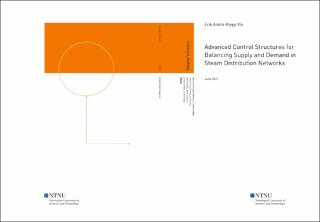| dc.contributor.advisor | Skogestad, Sigurd | |
| dc.contributor.advisor | Zotica, Cristina | |
| dc.contributor.author | Vik, Erik Andre Klepp | |
| dc.date.accessioned | 2022-02-01T18:31:26Z | |
| dc.date.available | 2022-02-01T18:31:26Z | |
| dc.date.issued | 2021 | |
| dc.identifier | no.ntnu:inspera:82941058:13545716 | |
| dc.identifier.uri | https://hdl.handle.net/11250/2976529 | |
| dc.description.abstract | Denne masteroppgaven presenterer en overvåkende kontrollstruktur basert på PID-kontrollere, for å balansere tilbud og etterspørsel i et dampnettverk. Deretter blir prestasjonen sammenliknet med en modellprediktiv kontroller. Dampnettverket består av seks høytrykksleverandører, som ledes gjennom et middels trykksatt hovedrør og deretter ut gjennom seks middels trykksatte forbrukerrør. For modellering av nettverket, ble programvaren MATLAB med Simulink og den ikkelinære programvaren CasADi brukt.
Den overvåkende kontrollstrukturen brukes til å kontrollere nettverkstrykket. Den bruker ideen om et tidsseparert kontrollsystem som involverer primær (rask), sekundær (tregere), tertiær (treg) og kvaternær (tregst) kontroll. Primær kontroll består av proporsjonal trykkontroll på nettverkets leverandørside. I sekundær kontroll blir proporsjonal-integral trykkontroll på nettverkets leverandørside brukt. Tertiær kontroll bruker enten parallell kontroll, kontrollere med forskjellige settpunkter eller ventilposisjonkontroll på leverandørside. Til sist bruker kvaternær kontroll proporsjonal-integral trykkontroll på forbrukersiden når primær, sekundær og tertiær kontroll er mettet.
To karakteristiske forbrukere uten kontroll presenteres også. Det er ufrivillige droop-forbrukere som ikke har noen kontroll involvert, men blir selv-regulert på grunn av nettverkskobling. Normale forbrukere er den andre typen, bestående av enkeltsløyfede integralkontrollere for ventilposisjon. Begge forbrukerne opptrer som systemforstyrrelser.
Den desentraliserte kontrollstrukturen med kontrollere med forskjellig settpunkt for den tertiære kontrollstrukturen viste de mest lovende resultatene for stabilitet og opptreden. Ventilposisjonkontroll viste også lovende resultater, men responderte saktere enn kontrollere med forskjellig settpunkt. Den modellprediktive kontrolleren viste gode intiell respons, men hadde problem med å returnere til normale kontrollerposisjoner. Parallell kontroll hjalp ikke for å kontrollere dampnettverket da det ikke klarte å fullt utnytte de tertiære kontrollerne. | |
| dc.description.abstract | This master thesis proposes a supervisory control structure based on PID controllers for balancing supply and demand in a steam distribution network. It is then compared to a model predictive control for performance comparison. The steam distribution network comprises six high-pressure supplier pipelines, directed through a main pressure pipeline diverted to six medium pressure consumer pipelines. For modeling, the programming software MATLAB with Simulink and the nonlinear optimization software CasADi were used.
The supervisory controller structure is used for controlling maintaining network pressure. It uses the idea of a time scale separated control system involving primary (fast), secondary (slower), tertiary (slow), and quaternary (slowest) control. The primary acting control consists of proportional pressure control on the network producer side. In the secondary acting control, proportional integral pressure control is used on the producer side. The tertiary control uses either parallel control, controllers with different setpoints, or valve position control on the producer side. Last, the quaternary control uses proportional integral control on the consumer side when primary, secondary and tertiary controllers are saturated.
Two remaining consumer types are proposed. That is the involuntary droop consumers who offer no control but are self-regulating due to network coupling and normal consumers, being single loop integral valve position controllers. Both involuntary droop and normal consumers act as a system disturbance.
The decentralized controller structure using controllers with a different setpoint for the tertiary control structure showed the most promising results regarding stability and performance. The valve position configuration showed promising results, however, responding slower than the different setpoints structure. The model predictive controller showed good initial results but had problems returning to nominal positions again. The parallel control configuration did not help control the modeled steam network as it did not fully utilize the tertiary controllers. | |
| dc.language | eng | |
| dc.publisher | NTNU | |
| dc.title | Advanced Control Structures for Balancing Supply and Demand in Steam Distribution Networks | |
| dc.type | Master thesis | |
